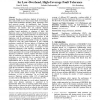Free Online Productivity Tools
i2Speak
i2Symbol
i2OCR
iTex2Img
iWeb2Print
iWeb2Shot
i2Type
iPdf2Split
iPdf2Merge
i2Bopomofo
i2Arabic
i2Style
i2Image
i2PDF
iLatex2Rtf
Sci2ools
ASPLOS
2006
ACM
2006
ACM
Understanding prediction-based partial redundant threading for low-overhead, high- coverage fault tolerance
Redundant threading architectures duplicate all instructions to detect and possibly recover from transient faults. Several lighter weight Partial Redundant Threading (PRT) architectures have been proposed recently. (i) Opportunistic Fault Tolerance duplicates instructions only during periods of poor single-thread performance. (ii) ReStore does not explicitly duplicate instructions and instead exploits mispredictions among highly confident branch predictions as symptoms of faults. (iii) Slipstream creates a reduced alternate thread by replacing many instructions with highly confident predictions. We explore PRT as a possible direction for achieving the fault tolerance of full duplication with the performance of single-thread execution. Opportunistic and ReStore yield partial coverage since they are restricted to using only partial duplication or only confident predictions, respectively. Previous analysis of Slipstream fault tolerance was cursory and concluded that only duplicated instr...
| Added | 13 Jun 2010 |
| Updated | 13 Jun 2010 |
| Type | Conference |
| Year | 2006 |
| Where | ASPLOS |
| Authors | Vimal K. Reddy, Eric Rotenberg, Sailashri Parthasarathy |
Comments (0)

